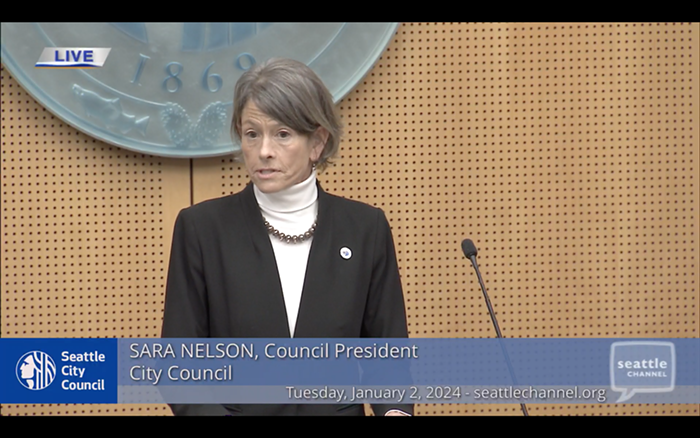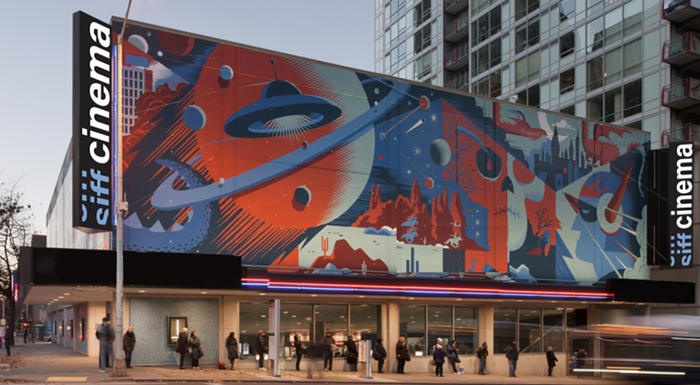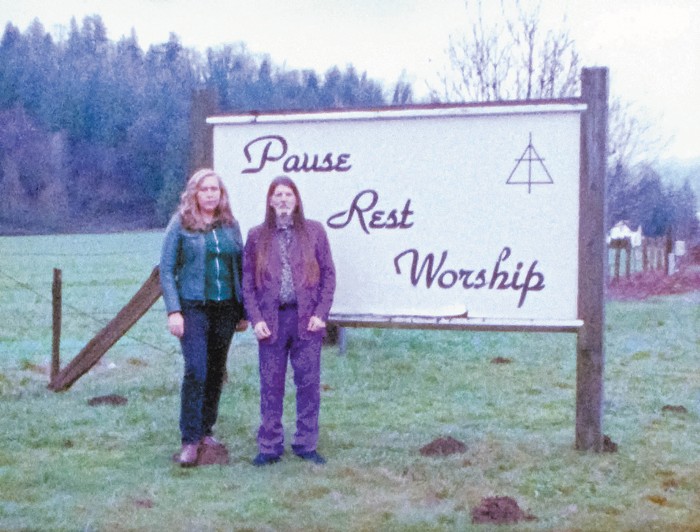Stephen Dooley heard a jackhammer gouging into the side of the 1925 building where he works on Eighth Avenue and Lenora Street on a Saturday afternoon in mid-July. High above the sidewalk, a man on a cherry picker aimed the tool's tip at the ornate terra-cotta frieze that wraps around the two-story structure, then dug into the brittle tiles. "You'd have to be deaf not to hear it. The jackhammer was against the tiles, and they were smashing on the ground," Dooley says.
"I asked, 'What are you doing? Are you repairing something?'" says Dooley, who studied historic preservation at the University of Georgia. "He didn't know exactly what was happening; he was just doing what he was told to do."
Defacing the intricate facades of old downtown buildings isn't new. The Ames Building, a 1914 building on Second Avenue and Stewart Street, was stripped of its white moldings last October and replaced with beige fake stucco. And the ornate tile work of another building, the Pande Cameron store at Ninth Avenue and Pine Street, was removed several years ago before the building was demolished. All three share something in common: Property owners and developers have plans to use the sites for tall buildings, even studying designs or submitting plans to the city. But if the existing buildings were to be declared landmarks, that would scotch their plans.
As part of the city council's decision several years ago to allow taller buildings downtown, former city council member Peter Steinbrueck commissioned a survey of all the old buildings affected by the new rule "so we could avoid threats to buildings due to redevelopment," he says. Other buildings are automatically surveyed if they are over a certain age.
The 1925 building on Eighth Avenue, formally called the Store and Loft Building for George L. Seibert (that's actually its name), "appears to meet the criteria of the Seattle Landmarks Preservation Ordinance," a Department of Neighborhoods inventory of historical sites declared in 2006. The building's architect, Earl Roberts, designed it in the beaux arts style. (He also designed the Fifth Church of Christ, Scientist—now the Rainier Valley Cultural Center—in Columbia City.) The most historic component of the Store and Loft Building was its detailed and colorful tile work. "The very striking terra-cotta cladding skin is surprisingly intact," the 2006 survey concluded.
Two weeks after the terra-cotta was damaged, someone complained anonymously to the city's Department of Planning and Development (DPD). Reached by phone, the anonymous person expressed concern that a piece of the city's architectural heritage was being destroyed. Indeed, flourished caps were smashed off, dozens of brightly colored tiles between the decorative scrolls had been gouged and cracked by the jackhammer, and parts of the finely detailed trim around the arching windows were broken.
"As an architect, it offends me that someone would do that," says Tyler Engle, who works a couple blocks away. "It's the terra-cotta that makes it impressive—that ornamentation."
But DPD spokesman Bryan Stevens says it's perfectly legal. The building was nominated as a landmark in 2006, but it failed to make the cut because the city's Landmarks Preservation Board—locked in a 4–4 vote—didn't give the building the six votes necessary to protect it. However, two board members, whose votes could have reversed the decision, weren't present at the meeting.
Absenteeism seems to be a recurring problem at the landmarks-board meetings, which require a quorum to be present but a majority of all voting members to declare a building a landmark. Records from the September 2006 meeting note that landmarks-board member Thomas Veith said that the vote for the similar Ames Building, the one on Second and Stewart, was "very close, and had more board members been in attendance, that may have affected the vote." That 1914 building—a terra-cotta-clad structure built in the boom following the Klondike Gold Rush—failed to receive landmark designation two years prior, even though board members voted to declare it a landmark by a 5–2 margin. Of the 12-member board (the board's size fluctuates), seven votes were necessary to make it a landmark, but five members of the board were absent, according to Sarah Sodt, coordinator of the downtown Landmarks Preservation Board. It too "appears to meet the criteria" of the landmark ordinance, the city had found. The building would have been eligible for another landmark nomination again this year, five years later. But last October, hammer-swinging crews broke off the terra-cotta trim and threw the pieces into Dumpsters. "They slipped under that five-year time frame," Sodt said last fall.
Each building that fails to become a landmark makes it more difficult for future buildings to achieve protection. For instance, minutes from the meeting about the building on Eighth Avenue show that board member John Schwartz reckoned that, because the Ames Building wasn't considered a landmark—again, probably because nearly half the board was absent—it would be difficult to argue that the building on Eighth could be landmarked.
In both cases, developers may have had financial motivation to strip off the terra-cotta trim. The Justen Company had submitted plans to the DPD for a 230-unit tower for the site on Eighth Avenue. And a spokesman for developer CollinsWoerman says that the landowners of the property on Second Avenue hired his company in 2006 to study plans for a 20-story office building on the site.
A building also may fail to get landmark status because no one advocates on its behalf. An attorney and a consultant representing developers for the building on Eighth Avenue each made eloquent arguments that the building wasn't a landmark. But nobody argued the other side, in favor of preserving it, to the board. If this were a panel of court judges hearing a case—or a jury—it would be the rough equivalent of hearing from two prosecutors but no defense attorney.
"People make different judgments based on the information they have been provided," board member Veith says. But he says board members aren't swayed by one-sided arguments from developers. As for absenteeism, he says, "People have lives. They can't be at every meeting."
Evan McMullen, the agent of the building on Eighth Avenue, which is owned by Cascadia Holdings, says the tiles were removed because some were loose and the owners wanted to see if they could be "recycled" (even though according to a witness they were smashed to fragments on the sidewalk). When asked if the building was being defaced to avoid future historic designation, he said, "Not to my knowledge."
The city's Department of Neighborhoods, which oversees the landmark-preservation process, refused to comment on whether there were flaws in the preservation process. Spokeswoman Lois Maag would only forward records. But this month, Landmarks Preservation Board coordinator Sodt did acknowledge that she heard the building on Eighth Avenue was being defaced.
City council member Sally Clark, chair of the city's land-use committee, acknowledges a problem. "Clearly the value of mowing down the buildings has been greater the last 10 years than keeping them," she says. "In some of the cases, we are going to lose the great buildings."
Clark intends to appoint a task force that could calculate incentives, such as tax breaks, to give property owners reason to preserve an old building instead of strip it and destroy it. She says the city may look at stricter rules, too. At a minimum, Clark should consider requiring attendance of all landmarks-board members at each meeting (or a voting alternate), requiring permits before altering any building in the historic survey (even ones not yet designated as landmarks), and prohibiting anyone with a financial stake in a building's demolition from advocating for or against its landmark status.
Clark can't do it soon enough—the city's stock of historic buildings is small and dwindling. Plenty of parking lots exist downtown where developers can build and where we can achieve density. But we need to close this loophole before losing another great building. ![]()


















